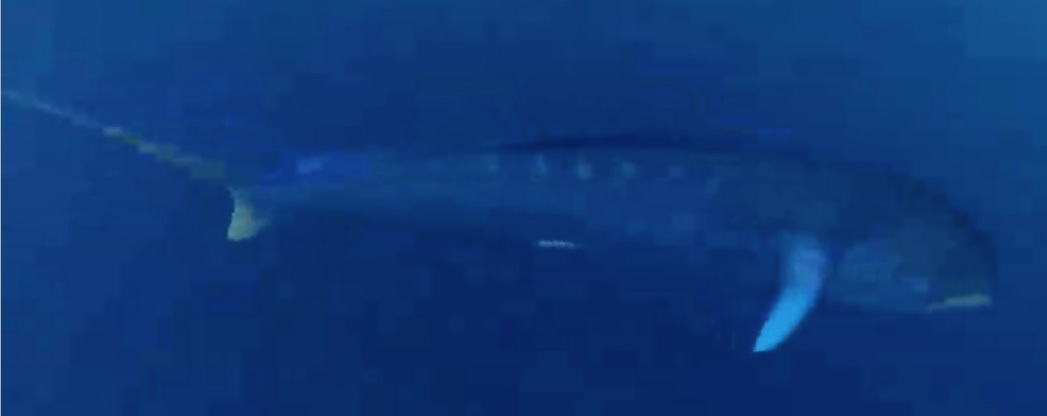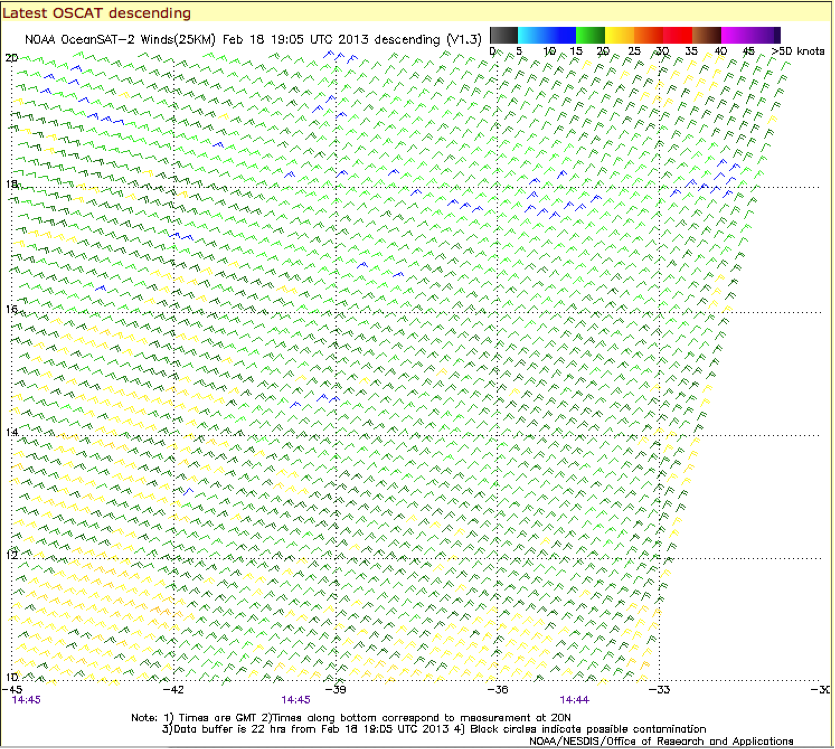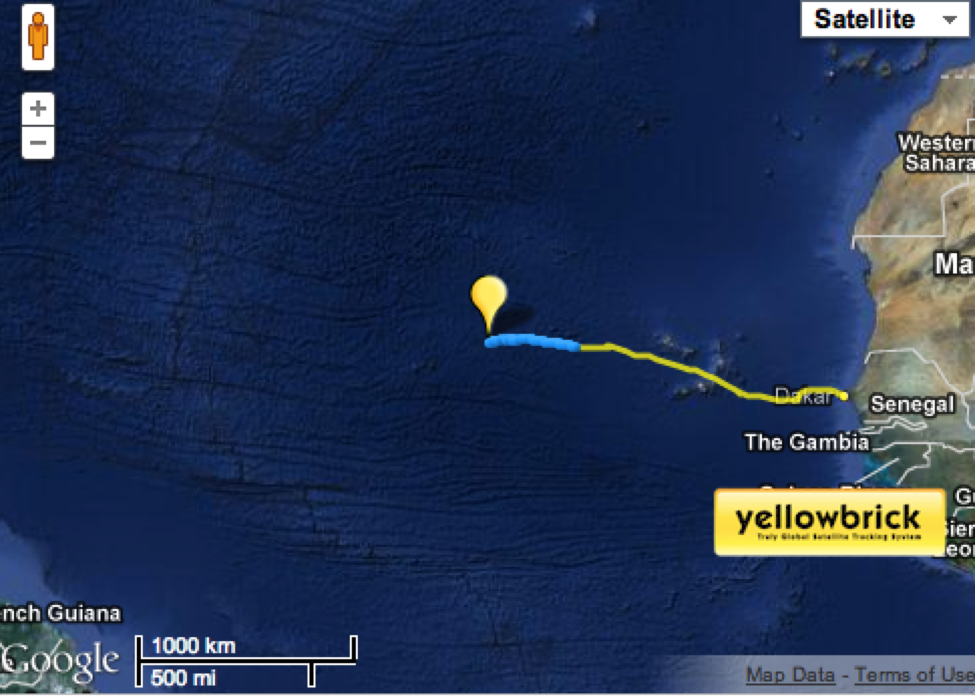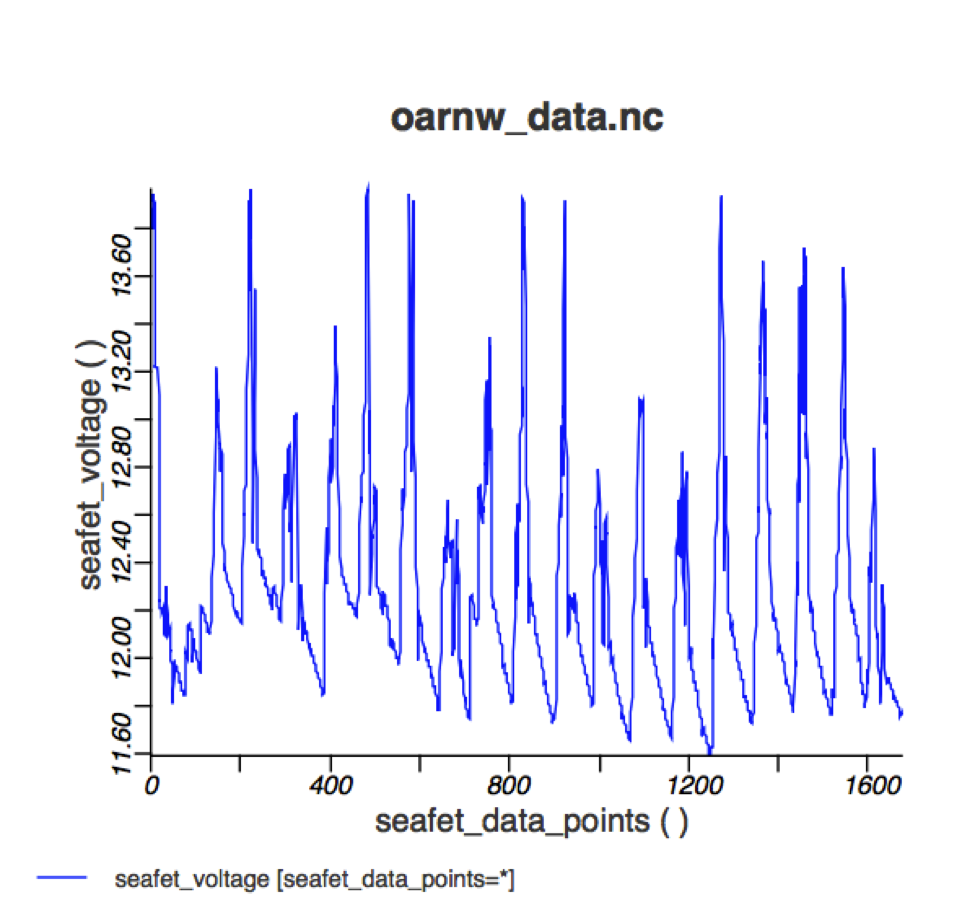Expedition Report
Week 4 – Module 2:2
Route so far:
Narrative summary of week prior:
This week has been a trying one.
From Greg, Mission control: Got a short message via the Yellowbrick at 10:21am (2/14/13): “No power. going black. yb in use.” We have SMS messaging option via the Yellowbrick, limited email in and out. They’re making fantastic progress overall, 1/2 way toward the mid-Atlantic Ridge, presently cruising between 2.5-3 knots.
Then on Friday this message, “just broke oar#2. on sea anchor.”
Despite these difficulties in a quick phone call to the chief forecaster Jordan relayed that -They’re all getting along well still, and they are still making progress despite having to be on sea anchor a couple of different times this week. They have established a threshold for going on sea anchor, 18 kt winds and 2 m waves.
Related to previous conversations about the boat, here is a graph from 2/13/13 of the boats voltage from Fritz Stahr, expedition scientist. This shows the fluctuating nature of the battery bank.
Finally, here is a great video about the expedition from one of the OAR Northwest Schools:
Introduction of Lesson going live:
Module: Lesson 2.2 Ocean Exploration and Human Impact
Last week’s lesson and updates focused on the traditions of exploration at sea. Concurrently, or very quickly thereafter, the information gathered about the oceans and distant lands were used to advance military and economic interests for mariners and their home lands. One example of this on a global scale is found in the histories and practices of the whaling industry. Famously, Herman Melville wrote of this period in maritime history in Moby Dick, however the impact of this era can be seen in many other venues of writing, art, architecture, seaboard urban growth, and geo-political events of the time. In preparation for next week’s focus on Ocean Science Lesson 3.1, this week will offer an investigation into the historic human impacts on the seas.
Images from week prior:
From the boat!
Video shot by Markus Pukonen


Navigation Forecast:
Navigation and weather forecast imagery can be found at David Burch’s site http://www.starpath.com/oarnw/ anytime. Some highlights from the last week are included below.

The forecast team at UW writes on their blog: http://uwams.wordpress.com/
Current Conditions (for the boat): The satellite is showing 75% cloud cover over you. There appears to be more cloud breaks on the way. You are in a broad region of 15-18 kt winds from North Northeast. Right now there are weak surface currents, 0-1 kt. Sea surface temps are 28-32C. Wave heights are about 2 meters, waves coming from the NE. The anticyclone is still to your North.
Short term forecast: Clouds should break up over the next few hours as the overall cloud mass moves toward the west. Winds will continue to remain strong NNE at around 15-18kts for the next 48 hours and then switch to Easterly by 72 hours. Temps should stay around 22-25 C. There is an eddy to your Northwest, but you are still too far away to feel its existence. Currents are very disorganized and unpredictable. 32 hour currents are still are around 1 knt, and by 44 hours there will be a slight increase. Wave heights will stay around 1.5-2m and continue to be from the Northeast.
Long term forecast: As the gyre moves across the North Atlantic, your wave heights and direction will remain the same until 96hrs, then will increase to 4-5m and be directly from NNW, and by 156 hrs they will decrease back to 1.5m. Weather conditions should remain relatively constant as the anticyclone moves.
Next 12 hours:
Winds: 15-18 knts, NNE
Clouds: 65-85% cloud cover, with some breaks
Currents: 1.5 kts
Waves: 2m heights, Northeasterly, with a higher easterly component.
12-18hrs:
Winds: 15-18 kts
Clouds: 95% cloud cover, mostly cloudy
Currents: 1-1.5 kts, slightly westerly
Waves: 2m heights, Northeasterly, with a higher easterly component.
18-24 hrs:
Winds: 15-18 knts, NNE
Clouds: 65-75%, possible breaks
Currents: current picks up, 1.5-2kts, westerly.
Waves: 2m heights, Northeasterly, with a higher easterly component.
Forecasters: Chaplin and Bayern
Wave data can be observed on Angie Pendergrass’ (Expedition Scientist) site http://oarnw-currents.blogspot.com/
This is a 48-hour forecast, the ‘warmer’ the color, the higher the speed of the current in knots.



